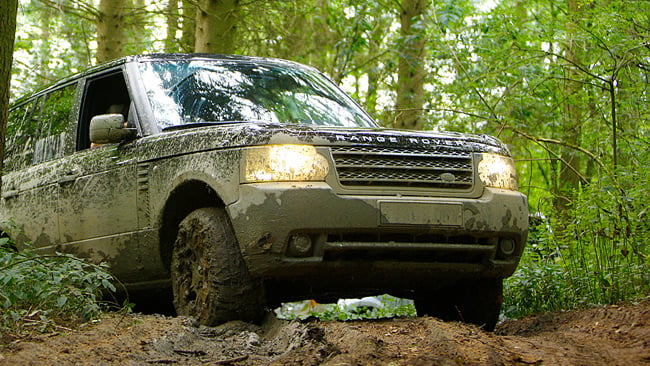Deep and brown, ranging in viscosity from sloppy to suck-your-boots-off, the mud of Eastnor Castle’s trails is diabolical.
Even isolated from filthy reality in the fragrantly leathered luxury of a Range Rover cabin, it’s hard not to be impressed by the way the fire keeps burning and the tyres keep churning.Behind the wheel, there’s never a moment of doubt that this heavyweight will punch through. In fact, it’s dead-easy driving. All you’ve got to do is keep the steering pointed in roughly the right direction and not do anything too dumb with the pedal connected to the supercharged 5.0-litre direct fuel-injection V8 in the engine bay.Although the Range Rover is often moving at a little more than walking pace, its progress depends on messages zipping at near the speed of light through its electrical system. The CAN (controller area network) relays messages from the Rangie’s battalions of sensors to its computerised command and control centre.The data is fed to algorithms (mathematical formulas that respond with military precision to incoming information) and orders sent to engine, brakes and suspension.Little mental effort and even less physical activity is required of the driver. It’s simply a matter of taking a look at what’s ahead, and twisting the Terrain Response dial to match the view. This Land Rover trademarked tech isn’t new, but it’s been improved for the updated 2010 Range Rover (and Rangie Sport and Discovery 4, too). Simple graphics, rather than words, are used to indicate its various modes.They are, going clockwise round the dial, Snowflake, Fir Tree, Cactus and Driving Over Beach Ball. It’s not hard to figure out that modes one and three are for snow and sand driving. The second turns out to be for muddy forest trails, like Eastnor, while the last is for crawling over big rocks rather than inflatable playthings.Each setting trims the Range Rover’s pneumatic suspension to the best height for the conditions, and invokes specific software to optimise the activity of the traction, brake and drivetrain control systems for the surface selected.Depending on the speed desired, the driver may have to make a couple of supplementary decisions. Need to crawl? Flick a switch to select low-range gearing, press a button for Hill Descent Control and the Rangie goes into slo-mo.The way the Range Rover lumbers unstoppably through the Eastnor mud is a convincing demonstration of the power and flexibility of contemporary automotive electronic tech. It would be easy to take it for granted, but for a reminder of the way things used to be. Not so long ago, either.As well as the fleet of 2010 Range Rovers, there are a bunch of museum pieces available for driving, though only in the less challenging environment of Eastnor Castle’s almost mud-free deer park. Some of them were developed here, as the estate has been used by Land Rover for off-road testing since the 1960s.The presence of these old-timers makes a point about Land Rover’s long-time expertise in off-roadery and the brand’s iconic status. There are two tiny 1949 Series I Land Rovers, a military 101-inch forward-control, a Series III wagon, one of a group of Defender pick-ups made up for an appearance in a Lara Croft movie, and a 1993 Range Rover.Driving them all, in as close to chronological order as possible, the similarities between old and young are striking. There may be more than 40 years difference in age between a Series I Land Rover and the mid-1990s Range Rover, but the relationship, the line of technical descent, can be felt.Most obviously, both require the manipulation of levers for such tasks as the selection of low-range gearing and engagement of parking brakes. The absence of smart electronics makes the 1993 Range Rover closer, technologically, to a Series I Land Rover than a 2010 Rangie.While the latest Range Rovers show what digital tech can do for the off-roader, is this what their customers really need? Company executives cheerfully admit that the great majority of Range Rover customers never ever drive off-road.What the average Range Rover buyer really wants is an impressive amount of luxury and performance. For many customers it is, in the words of one Land Rover marketing exec, their “business limousine”. This is fine, but isn’t the likelihood of finding profit at the end of a muddy track through a damp forest rather low?While the marketing types blather on about the breadth of capability that the typical Range Rover buyer (wealthy and, with an average age below 50, younger than other luxe brand customers) desires, and how this justifies the focus on off-road capability, the engineers who worked on the 2010 model are more in touch with reality. Their objectives were to increase performance, lower fuel use and improve dynamics.Jointly developed with Jaguar, the 2010 Range Rover’s pair of new petrol-burning 5.0-litre V8s nails the first two targets. The 375kW supercharged and the 276kW naturally-aspirated versions bring big increases in power compared to their predecessors.The atmo direct-injection engine almost matches the old supercharged engine’s output, while the new supercharged brings a 29 percent power boost, yet both engines cut consumption by around seven percent. These are very, very good V8s; flexibly potent (especially the supercharged), authoritatively responsive, yet wonderfully refined. (There’s a diesel option, too, but it’s the same 3.6-litre V8 as before).Changes to the Range Rover’s suspension are significant, with the headline item a new adaptive damping system. There’s also a new variable ratio steering system, and brake hardware is upgraded. As with the Terrain Response for off-roading, the Range Rover’s on-road electronics have been upgraded. There’s fresh software to a) tame understeer, and b) sense a potential rollover and take corrective action.On the blacktop of the Herefordshire countryside around Eastnor, the 2010 Range Rover is a majestic thing to drive. It rides with stately grace, and steers with surprising precision. But agile it is not. The Range Rover is tall and its kerb weight more than 2700kg.And this is a problem. Despite the improvements in fuel efficiency from the new engine, the supercharged V8 Range Rover delivers a 22.6L/100km result in the European urban fuel consumption test cycle. Long experience indicates most drivers are more likely to achieve real-world consumption closer to this number than the 14.9L/100km combined cycle results.How much does the Range Rover’s seldom used off-road hardware add to its thirst? Hard to say. What is certain is that such heavy consumption is becoming less acceptable every day, especially in Europe.This is a trend Land Rover’s leadership knows it must respond to. Design director Gerry McGovern admits that Land Rover can no longer afford to be “harnessed” by its heritage. Sustainability must be taken seriously, but with a close eye on cost. “It’s about selecting technologies,” he observes, but one direction is quite clear. “We will focus on reducing weight”.Managing director Phil Popham admits that recent times have been tough going for Land Rover, which has had three different owners in the past decade; BMW (1994-2000), Ford (2000-2008) and Indian company Tata (2008-present). “It’s been very difficult under Tata, for a number of reasons,” says the executive, noting that Tata bought just in time for the GFC.Yet Popham is a big-picture type who sees opportunities ahead. “It may not feel like it right now, but the world is becoming more affluent.” This “is likely to continue,” he adds. And growing wealth means a growing global customer base for some brands. Popham’s view is that Land Rover is one of them, noting that the small premium SUV market presently is the world’s fastest growing segment. And he promises deeper cuts to fuel consumption are coming. “We will have hybrids in future,” he promises.Land Rover has always been good in the deep brown stuff. If it makes the right decisions, builds the right products, it will find the traction to haul itself out of the mire. But the next Range Rover to emerge from the merde seems sure to be a quite different beast from today’s.






